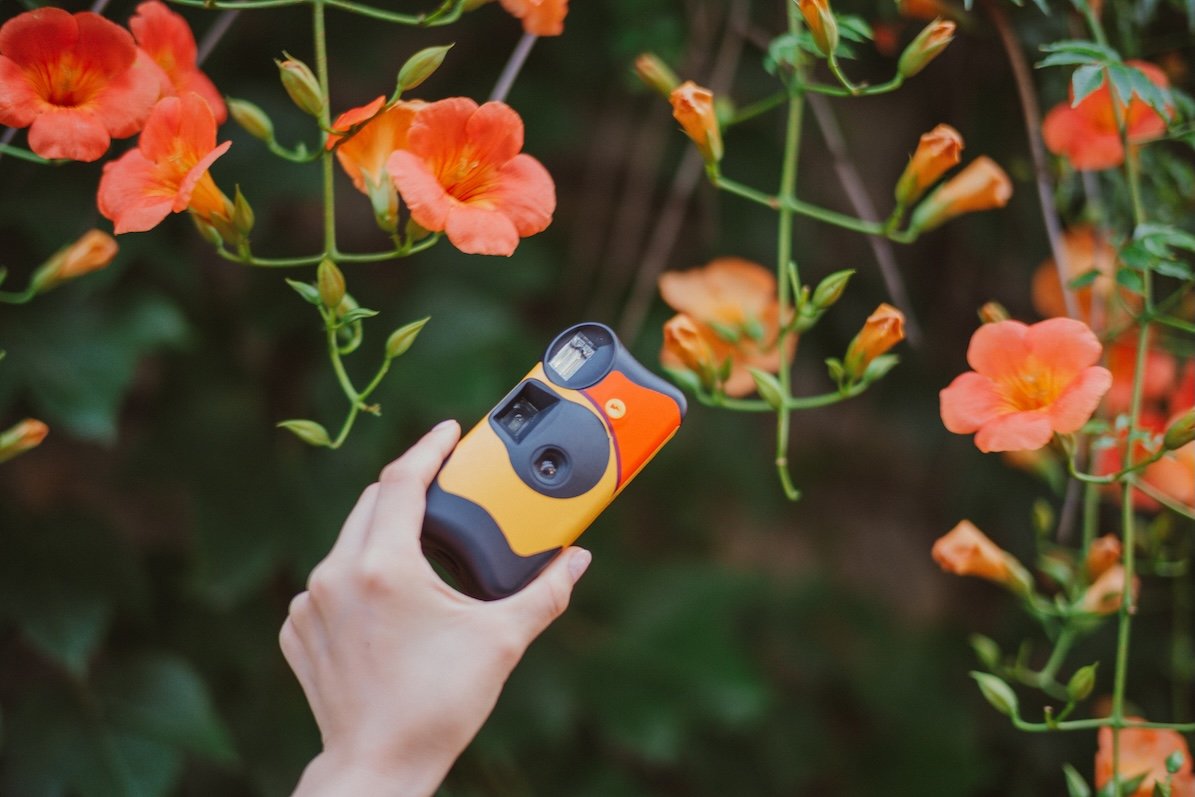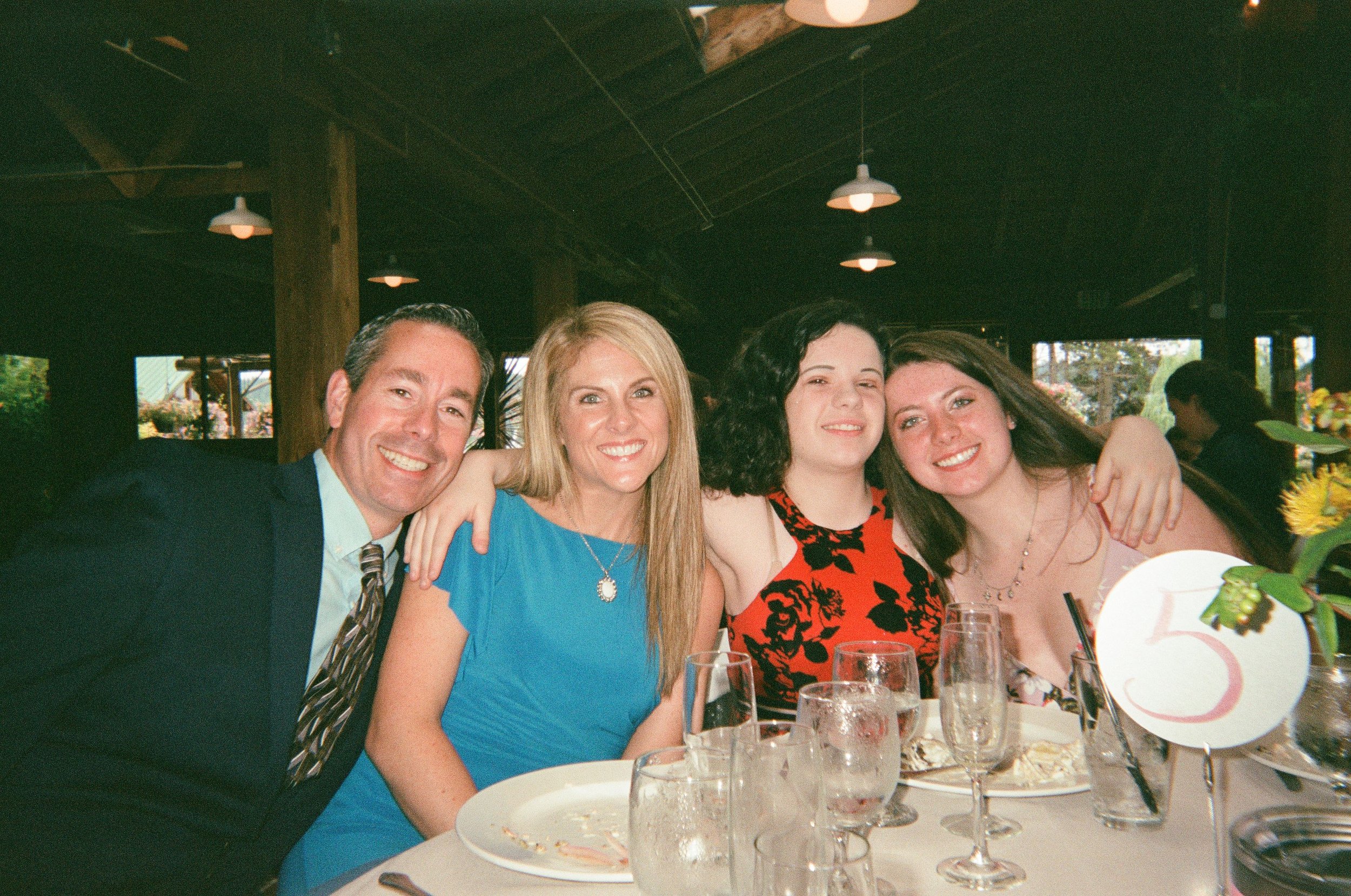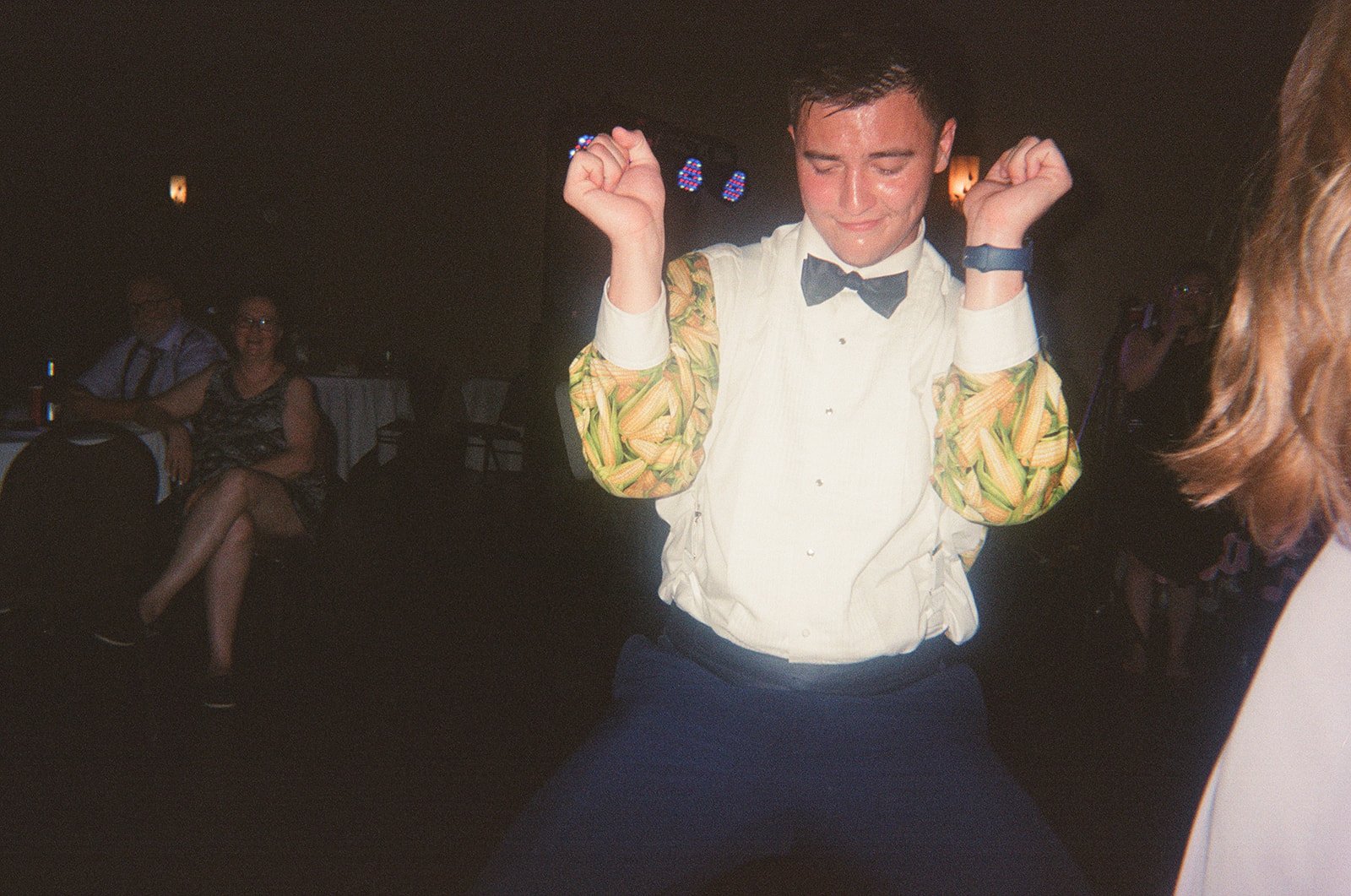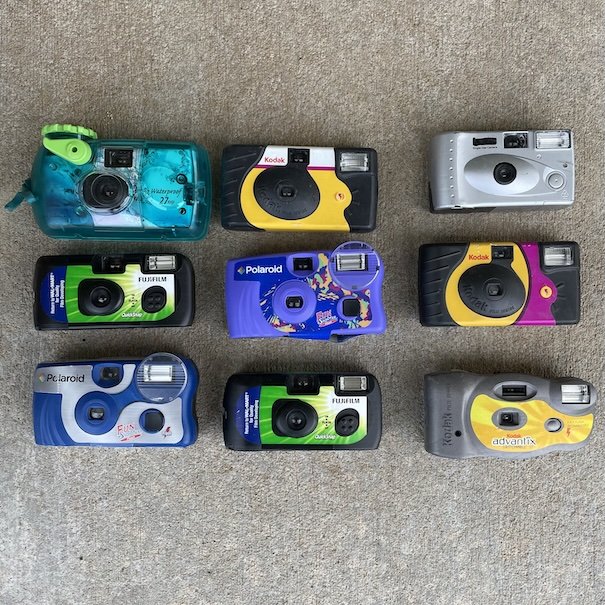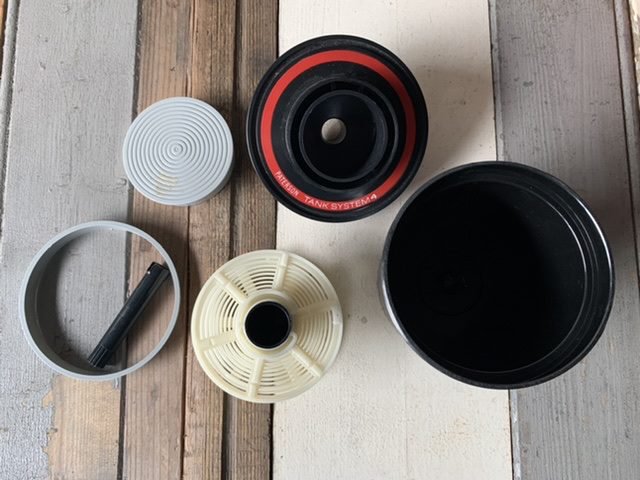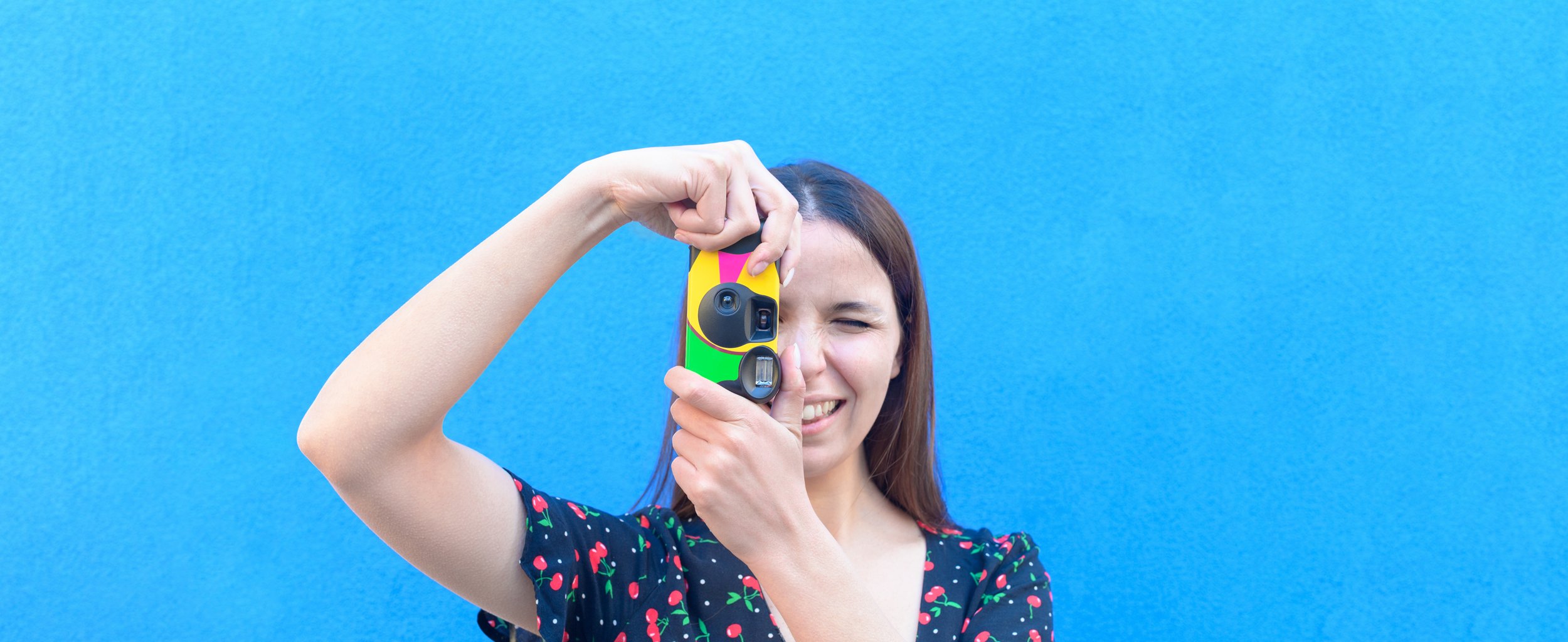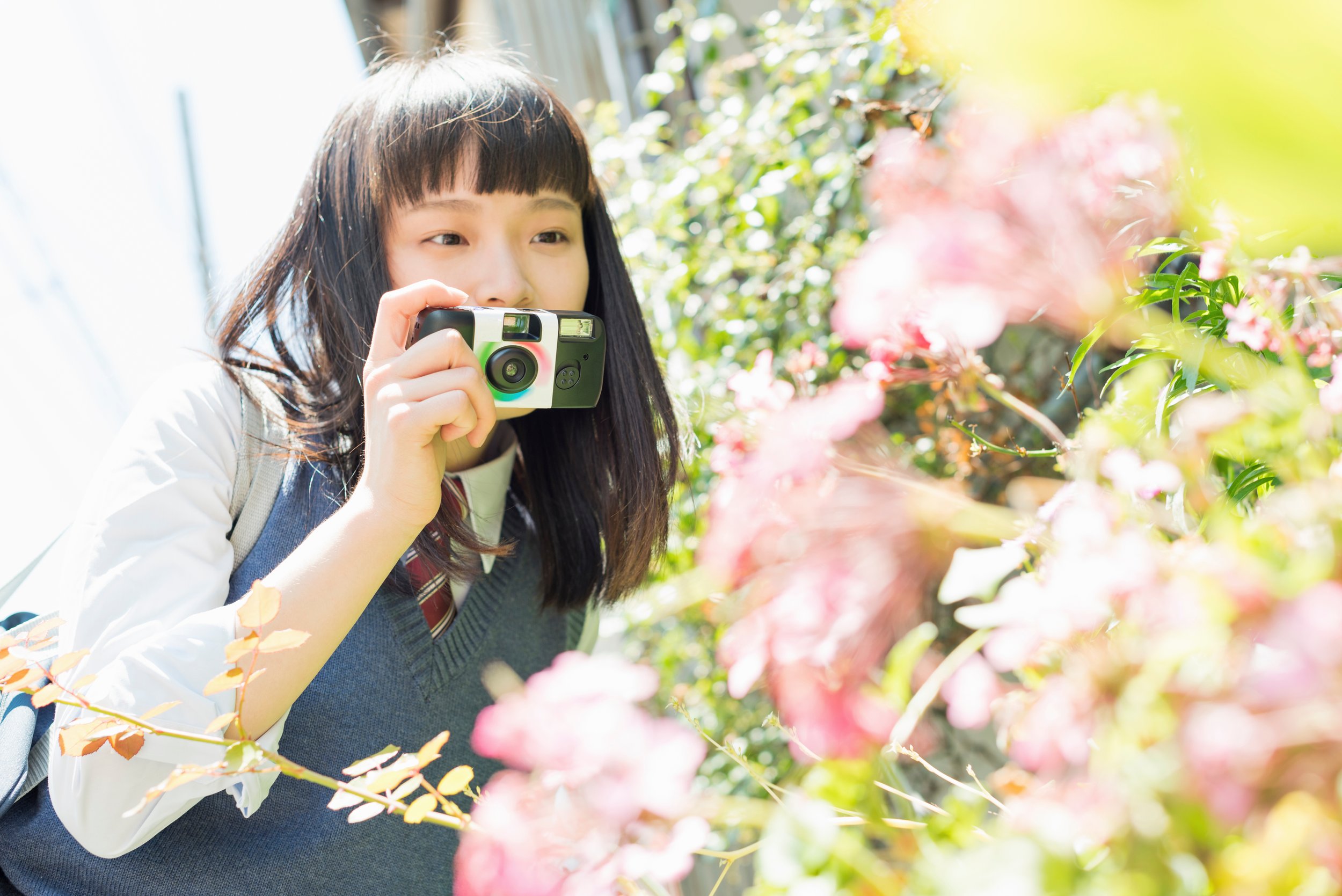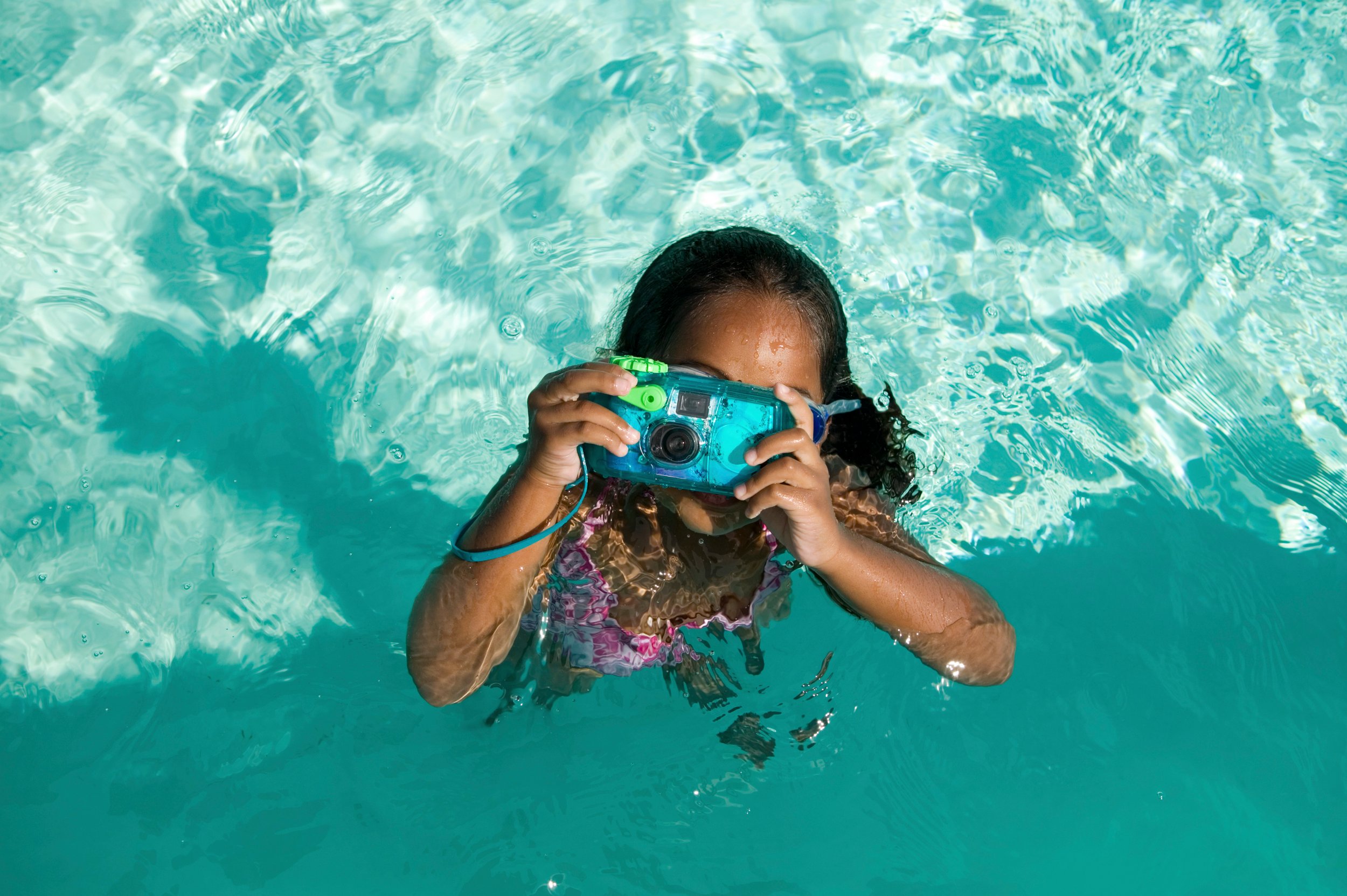The Best 5 Disposable Cameras for Your Adventures
Disposable cameras are all the rage this summer and here are the best 5 cameras to take with you on your summer adventures!
As the summer sun shines brightly and adventure calls, there's no better way to preserve your memories than with a disposable camera. These handy devices combine the charm of analog photography with the convenience of disposability, making them perfect for capturing spontaneous moments without the fuss of digital settings. Whether you’re hitting the beach, going on a road trip, or enjoying a backyard barbecue, here are the top five disposable cameras to consider for your summer escapades.
1. Fujifilm QuickSnap Flash 400
Features:
Film Speed: ISO 400
Exposures: 27
Flash: Built-in
The Fujifilm QuickSnap Flash 400 is a staple in the world of disposable cameras. Known for its reliability and high-quality images, this camera is perfect for both indoor and outdoor settings. Its ISO 400 film speed ensures that your photos will be clear and vibrant, even in low-light conditions. The built-in flash makes it easy to capture moments after the sun goes down, ensuring your summer nights are just as memorable as your days.
2. Kodak FunSaver
Features:
Film Speed: ISO 800
Exposures: 27
Flash: Built-in
Kodak’s FunSaver is another top contender, offering a higher ISO speed of 800, which is excellent for capturing action shots and low-light scenes. This camera’s vivid colors and sharp details make it a favorite among travelers and party-goers alike. The easy-to-use design means you can hand it off to anyone, ensuring no moment goes undocumented.
3. Ilford HP5 Plus Single Use Camera
Features:
Film Speed: ISO 400
Exposures: 27
Flash: Built-in
Specialty: Black and white film
For those who appreciate the classic look of black and white photography, the Ilford HP5 Plus is the ideal choice. This camera uses Ilford’s renowned HP5 Plus film, providing rich contrasts and a timeless aesthetic. Perfect for artistic shots and moody summer evenings, this camera will add a touch of elegance to your photo collection.
4. Lomography Simple Use Color Negative
Features:
Film Speed: ISO 400
Exposures: 36
Flash: Built-in, with color gel filters
Specialty: You can reuse the camera as many times as you want by reloading film!
Lomography’s Simple Use Color Negative camera stands out with its fun and creative features. It comes pre-loaded with Lomography’s vibrant color negative film and includes three different color gel filters for the flash. This allows you to experiment with different color effects, adding a unique twist to your summer photos. With 36 exposures, you’ll have plenty of film to capture your adventures.
5. AGFA Photo LeBox Ocean 400
Features:
Film Speed: ISO 400
Exposures: 27
Flash: Built-in
Specialty: Waterproof
If your summer plans include water activities, the AGFA Photo LeBox Ocean 400 is a must-have. This waterproof camera is designed to withstand the elements, making it perfect for beach trips, pool parties, and snorkeling adventures. With its robust construction and reliable performance, you can capture stunning underwater shots without worrying about damaging your camera.
Conclusion
Disposable cameras offer a delightful mix of nostalgia, convenience, and high-quality photography, making them a fantastic choice for summer adventures. Whether you prefer the vivid colors of the Kodak FunSaver, the artistic flair of the Ilford HP5 Plus, or the waterproof capabilities of the AGFA LeBox Ocean, there’s a disposable camera to suit every need. So, grab one of these top picks, and let the summer memories begin!
By choosing the right disposable camera, you'll ensure your summer memories are captured beautifully, ready to be cherished for years to come. Happy shooting!
Why is it Called a Disposable Camera
Why is it called a disposable camera? Sometimes you’d expect questions like this to have complicated answers but in the case of naming the disposable camera, it’s absolutely simple. They are called disposable cameras because once you are done taking pictures with them, you can just throw them away. But not before you’ve had the film inside developed or at least removed from the camera.
Can you really just throw away a Disposable Camera?
Yes and no. The name “disposable camera” can be a bit misleading. Disposable cameras are made of plastic bodies with a plastic lens and also have a battery and some electronics inside that help to operate the flash. While it is possible to just throw the camera away after you’ve used it, most cameras are sent off to be developed and photo labs handle the recycling or disposal of the cameras. A more accurate name that many have adopted lately for disposable cameras is “Single-Use Camera” as once used, you send the camera in rather than just throw it away yourself.
Can You Re-Use a Disposable Camera?
Some of them can easily be reused. Kodak FunSaver and Kodak PowerFlash disposable cameras can be reused, but the camera has to be disassemble, the used film canister removed and then in the dark, a new film canister rewound around the spindle because being put back into the camera. Other cameras have a hinge and button that makes reusing a disposable camera very easy. Some cameras, like the Fujifilm Quicksnap cannot be reused as the camera body is plastic welded together and breaks when you try to disassemble it. There are a class of cameras closely related to disposable cameras that feature a very silmilar construction but are designed to be reloaded and reused many times. These cameras are called Simple-Use Cameras.
Are Disposable Cameras Recycled after use?
Many labs do try to reused or recycle the disposable camera bodies after use. There are some companies that buy the spent bodies from photo labs and some photo labs, like ours have creative ways to repurpose and reuse cameras to prevent them from going to the landfills. Recycling can be difficult however and many disposable cameras are simply thrown in the trash.
A Disposable Cameras is a Single-Use Camera
The biggest thing to take away is that disposable cameras are designed for a single use by the consumer and then it’s up to the photo lab to find something to do with them. Their low price point and ability to take amazing photos has made disposable cameras very popular even today!
When to Use Disposable Camera Flash
Almost every disposable camera on the market today (with the exception of the underwater disposables) comes equipped with a flash. While they all have them, its hard to really know when you’re supposed to use the flash.
When Should I Use the Flash on my Disposable Camera
The general answer is simple, use the flash in any low-light condition. For an experienced photographer, that is an easy to understand term. But for all of you that aren’t used to using film cameras, the term-low light can be a bit misleading. Our eyes automatically adjust to lower light and while the room might seem perfectly bright enough to take a picture, you only tragically find out later on that it was just too dark when you get a black frame with only forms or shadows of what you were trying to take a picture of. As a general rule, here is what we tell our customers about using the flash on their disposable camera:
Always use the flash indoors
Always use the flash at night
Always use the flash at weddings
Always use the flash at parties
Always use the flash at indoor concerts
Always use the flash inside of a vehicle
When you are not sure, just use the flash anyways
Why is the flash on a disposable camera always necessary?
Unlike our eyes and our cell phones, film has a fixed sensitivity to light, meaning that it requires a certain amount of light to make an image on the film. Your camera on your cellphone as well as all digital cameras have adjustable image sensors that can adapt to any lighting environment. The film is fixed and the camera itself is also fixed to one setting. On most cameras you can adjust the shutter speed and aperture, but disposable cameras have fixed settings that cannot be changed. Because of this, disposable camera manufacturers added the flash as a way to compensate. The disposable camera system (film and camera) were specifically designed to work with the flash so that even in very dark spaces, you can turn on the flash and you will be able to produce an image.
Disposable camera photo inside without a flash
Same couple, same pose but they turned the flash on!
How do you turn on the flash on a Disposable Camera?
Each camera is different, but for the most part there are two types of flash systems. Kodak cameras and a few others use a “press to charge” button. Once the button is pressed, a capacitor is charged and the flash will then work several times before completely discharging. Once it is discharged, you have to press the button to recharge. This system usually utilizes an indicator light that grows in brightness from dim to bright to indicate the charge contained in the flash.
Fujifilm Quicksnap cameras use and on/off button. When turned on, the flash is continually charged up by the battery and when turned off that flash will not work. These types of cameras work better at weddings and events in dark spaces where the flash will be needed continuously.
What happens if I don’t use the flash on my disposable camera?
More than likely, you’ll simply get a black frame, which means whatever you were trying to take a photo of won’t make a photo. Once exposed, there is no way to save that image or recover it. There’s nothing your lab can do it developing or in post to really bring that lost image back.
Wedding Reception Photo without the flash
Same wedding reception photo with the flash on
Best Advice - Almost always use the flash
When using a disposable camera, the best advice we can give you is to always use the flash unless you are outside in the direct sun or sand or a snowy place. Even if there’s some light, the flash will help to fill in shadows and give you a more pleasing image!
When Can I get my Disposable Cameras Developed?
Disposable cameras are made to be shot and then developed immediately. As soon as you finish shooting the last frame on the roll of film, you can take your cameras to your preferred photo lab and get it developed!
There is no need to wait as once you click the shutter, the film is exposed and holds on to the latent image until the camera is processed. Ideally, you want to get the cameras developed as soon as possible but as a general rule, you have about 6 months until the the images on your disposable camera begin to be affected and degrade.
How Long will Disposable Cameras Last
This is a common question and one we have explored in detail in other blog posts. You have around 2 years from the manufacture date of the film. The cameras expiration date is printed on the bottom of the camera usually. You can still shoot and develop a disposable camera after it expires, as they do not really go bad. You just might not get as good of results from an expired camera.
Where can I go to get my disposable camera developed?
You have a lot of options, from local labs, local big chain stores like Walgreens and CVS, and online developing companies. We have an online developing service and specialize in developing disposable cameras. If you’d like to find out more about getting your film developed with us, click the button below!
How Long Will Disposable Cameras Last - Do They Expire?
by Tony Brown
Milk expires, bread expires, but did you know that disposable cameras also expire? Most people never notice but on most disposable cameras is printed an expiration date, based on the manufacture date of the film inside. But expired doesn’t meant it’s bad and needs to be thrown away. Here’s what happens when a disposable camera goes bad.
How long do disposable cameras last?
The industry standard seems to be 2 years from the film manufacture date. The expiration date is usually printed on the bottom of the camera and gives you the month and year the cameras expire. While cameras are created with a 2 year expiration, the time it takes to distribute and sell the cameras eats into that time. It is not uncommon to get a disposable cameras with only a year left until expiration.
But expiration doesn’t actually mean the camera is not good any more. The expiration date represents the window of time that the manufacturer guarantees that the film will meet their original standards. After a disposable camera expires, it will still function and take pictures. As they get older, the quality of the images will begin to decay.
Can you still take Pictures on a disposable camera after it expires?
Yes! You can still take pictures on a disposable camera after it expires. However, as the film ages the images that will be produced will become flatter and less saturated. In our photo lab, we have seen images taken after the cameras have been expired for 10 to 15 years and they still develop well enough to make a usable image. You just need to be prepared for the images to not look great.
Can you still develop a disposable camera after it expires?
Yes! We develop old disposable cameras every day. You can still get some good pictures, depending on the brand of camera and how it was stored,. We have another article on developing disposable cameras and film in general after it expires. You can read all about developing old disposable cameras and film here!
Develop your Disposable Cameras soon to get the best results
As a general rule, you have until the expiration date to take the photos on your disposable camera and around 6 months afterward to get them develop before noticeable decay happens. Our lab has a special process that we use for older film. So if your disposable camera has gotten old, don’t panic! We can help you get the most out of those old disposable cameras! Just click the button below to find out more about getting your disposable developed!
Are Disposable Cameras Refillable?
We all love disposable cameras. They’re fun, durable, portable, and take photos with a very unique look. But once you’re done shooting, do you really just have to throw them away? Can you reuse a disposable camera?
Can You Reload a Disposable Camera?
The answer is YES and NO, depending on what type of disposable camera you have. The Kodak disposable cameras (Funsaver, PowerFlash, Professional Black and White) are all reloadable. The plastic camera bodies pop apart and the counter can be reset and film reloaded (in the dark only).
The Fujifilm Quicksnap disposable camera is not. The Quicksnap has several plastic welds that have to be broken to get the camera apart. Once those plastic welds are broken, the camera has light leaks that can only be covered by using electrical tape.
Other, less popular brands of disposable cameras are not really reloadable. The Ilford black and white disposable cameras can be reloaded but they are a little more difficult to load.
How do you reload a disposable camera?
Here’s a quick overview on how to reload a Kodak disposable camera!
Make sure all of the photos on the camera are taken and the film winder spins without stopping
Remove the label from the camera
with a flat head screwdriver, insert the tip into the tabs located on the sides of the camera
Use the flat head to release the clip on the top of the camera
Carefully remove the back of the camera
Remove the film canister from the camera
Get your film developed! Click Here to get your film developed by Shutter Junkies
Reset the exposure counter the top of the camera to 27
Take the camera and your new roll of film (make sure it’s ISO 400 and up!) into a dark room with absolutely no light
Remove the empty spindle from the camera
Insert the film leader into the spindle
Turn off the lights
Wind the film around the spindle until all of the film in the canister is out and wound around the spindle
Make sure to keep the film tight and don’t let it unspool
Carefully replace the spindle and put the film canister in the camera
Make sure the film fits onto the little sprocket wheel under the film counter (this is how the counter works and the shutter is armed)
Replace the back of the camera - make sure everything tightly clicks into place
Turn on the lights and start taking photos
Simple-Use Cameras - Designed to be reloadable
If you’re looking for something that isn’t so wasteful as a disposable camera and also is really easy to reload, you might want to look into Simple-Use Cameras. There are several different Simple-Use Cameras on the market, some come loaded with film and others are empty and ready to be loaded with your choice of film. Some of the most popular simple-use cameras are made by Lomography. You can purchase Simple-Use Cameras directly from Lomography and also from Amazon. These cameras come pre-loaded with different types of film from Black and White to some very unique color films. You can also purchase Simple-Use cameras that come empty and ready to be loaded with your choice of film.
The Disposable Camera Look: Examples of Images from Disposable Cameras in the Real World
What types of images can you get from a disposable camera?
We’ve all become so used to our iPhone and Android cameras that we’ve forgotten what film photos and disposable camera photos actually look like! The disposable camera look is unique thanks to its use of 35mm film, the fixed aperture and shutter, a plastic lens, and a super bright flash.
And even though a SLR 35mm or point and shoot film camera might also use 35mm film, there is definitely a distinct difference between those more traditional cameras a disposable.
Wide Angle Close-Ups
Disposable cameras have a 30mm f/10 lens which gives a pretty wide field of view. This is great for getting all of your friends in one photo or getting a wider angle of the event your at or the scenery. The only issue you have to worry about is the minimum focal length, which is about a meter. Holding your camera up and snapping a selfie might leave your a little out of focus.
Amazing Candids
Even though a disposable camera doesn’t have any filters or multiple lenses and zooms, they do have one advantage - SPEED! Disposable cameras are purely mechanical and as soon as you click the button the photo is taken. There’s no focus or adjustment delays like you see in taking pictures with a cell phone. It is honestly very hard to try to get an actual candid shot with an iPhone or Android camera.
With your camera wound and flash ready, you can call your friend’s name and snap the picture before they even know what happened.. The camera’s focus is set and it can get almost everything in focus. Disposable cameras are the best tools for genuine candids!
Action Shots
Disposable cameras come with a smaller aperture and a decently quick shutter, enough so that you can freeze some pretty great action shots! In order to get the best action shots, it always helps to use the flash. Just relying on ambient light might cause you to have some motion blur, but the flash will help you to freeze your subject at the moment you click the shutter.
Beautiful Nature Shots
Disposable cameras and the film inside love daylight and really thrive in sunlight. Add all that natural light with a beautiful mountain, rolling prairies, or colorful trees and you get some stunning images! The disposable camera set up allows for almost infinite focus, meaning that you can capture images of nature close up and far away.
The Best Party Pictures
Everyone loves a good party and disposable cameras add an element of fun and spontaneity that makes any party even better! Whether its a college party or wedding reception or a even a kids birthday party, guests come alive when someone breaks out a disposable camera.
Things to remember when using a Disposable Camera
If you want to get amazing images like the images above, you need to make sure you’ve got enough light. If you’re in a dark place, or inside, always use your flash! Even if you’re in the shade, use your flash to make sure you’ve got enough light to make a good image. A bar is definitely too dark to take a good picture without the flash. Concerts are ok if you’re taking pictures of friends that are close by, but trying to capture the performers on the stage won’t really work because there won’t be enough light.
Don’t forget that you have to wind your camera after taking a photo. Get in the habit of winding immediately after you click the shutter so that you’re ready for the next shot. There’s nothing more frustrating than trying to take a picture only to discover that the film isn’t wound and the shutter isn’t ready.
Get The Best Images by Sending Your Disposable Camera to the Experts for Developing
There are a lot of great labs out there that can develop your disposable cameras, but we are the industry experts in developing disposable cameras at Shutter Junkies. We offer affordable prices, lots of scan and print options! Click the button below to order developing for your disposable cameras and then you can check out your own amazing images!
Disposable Camera Developing - What you Need to Know
Once your finished taking pictures, where can you get your disposable camera developed?
Developing disposable cameras is a straightforward process, with several options available to suit your needs. Here's a comprehensive guide to help you choose the best method for developing your disposable camera film.
There are a lot of options out there and if you’re new to disposable cameras of film photography, finding a photo lab the works for you might be overwhelming. Here’s a look at all of your options for getting your disposable camera developed!
Local Drugstores and Retail Chains
Many local drugstores and retail chains offer film developing services for disposable cameras. Popular chains like CVS, Walgreens, and Walmart provide convenient options, often returning your developed photos within a few weeks. These services typically include physical prints and a CD with digital scans.
Pros:
Convenient; widespread locations.
Cons:
Quality can vary; most only offer low-quality scans.
Not all branches offer film services; film is often shipped to third-party labs.
Poor customer service and lack of personalized attention.
Most do not return your film negatives.
Developing Costs:
Walmart: Charges by the number of exposures. For example, 27 exposures with prints cost $10.96, and 36 exposures with prints cost $13.96. Find out more at Walmart
CVS: Also charges by the number of exposures. For instance, 27 exposures with prints cost $15.86, and 39 exposures with prints cost $18.82. Find out more at cvs.com
Walgreens: Offers film processing for 24 exposures with prints at $15.99. Find out more at Walgreens Photo
These retailers often do not develop film on-site, leading to longer processing times. The mass-production approach may result in less personalized service, and there's a risk of negatives not being returned. Due to these factors, many photography enthusiasts prefer alternative options.
Specialty Photo Shops
For higher quality and more personalized service, specialty photo shops are an excellent choice. These establishments handle film with care and provide superior prints and scans. The staff's expertise in various film types and processing techniques can enhance the outcome of your photos.
Pros:
High-quality prints and scans; expert handling.
Cons:
May be more expensive; fewer locations.
If you reside in a larger city, you may have access to such stores. Pricing varies by shop, so it's advisable to contact local photo shops for specific information.
Mail-In Film Developing Services
Mail-in services offer a convenient alternative, especially if local options are limited. Companies like The Darkroom, Mpix, and Process One specialize in developing disposable cameras. The process involves mailing your camera to the service provider, who then develops the film and returns your prints and scans.
Pros:
High-quality results; convenient for those without local options.
Cons:
Longer turnaround time due to shipping; potential for higher costs.
Developing Costs:
Shutter Junkies Photo Lab: Shutter Junkies Photo are the disposable camera developing experts! Developing starts at just $12. Go to ShutterJunkies.com to get your disposable developed!
The Darkroom: Offers developing services starting at $16, with options for prints and digital scans. Find out more at thedarkroom.com.
Mpix: Develops disposable cameras and uploads images to a secure online album within 1-2 days after receiving your film by mail. Find out more at Mpix.
Process One: Develops all types of disposable cameras, including Kodak Funsavers and Fuji QuickSnaps. Find out more at Process One.
Many of these labs have been in business for years and develop all types of film. Prices and policies can change so check to find out if they return your negatives, what their turn-around time is, and compare pricing with the results you get.
DIY Development
For the photography enthusiast, developing your own film can be a fulfilling project. While this requires more effort and the purchase of specific chemicals and equipment, it allows complete control over the development process. Resources and kits are available online to help beginners.
Pros: Full control over the development process; rewarding.
Cons: Time-consuming; initial setup cost, cost of maintaining/replacing chemistry.
Choosing the Right Service
When deciding where to develop your disposable camera, consider the following factors:
Quality vs. Convenience: Determine whether you prefer the convenience of a local store or the quality of a specialty shop.
Budget: Prices can vary significantly between different services.
Turnaround Time: Some options might be quicker than others, especially if you need your photos soon.
Conclusion
When deciding where to develop your disposable camera, consider factors such as convenience, quality, cost, and whether you want your negatives returned. Local drugstores and retail chains offer convenience but may compromise on quality and personalization. Specialty photo shops provide superior quality and service but may come at a higher price and be less accessible. Mail-in services strike a balance between convenience and quality, making them a viable option for many.
By evaluating these options, you can choose the best method to develop your disposable camera film, ensuring your memories are preserved as you envision.
Disposable Camera Developing FAQ
Does Walmart Develop Disposable Cameras? - Yes
Does CVS Develop Disposable Cameras? - Yes
Does Walgreens Develop Disposable Cameras? - Yes
Does Target Develop Disposable Cameras? - No
Does BestBuy Develop Disposable Cameras? - No
Does Costco Develop Disposable Cameras? - No
How much does it cost to develop a disposable camera? - Between $10 and $24
Can I get digital pictures from my disposable camera? - Yes
From Click to Print: Navigating the World of Disposable Camera Film Developing
In a digital era where the instant gratification of seeing photos seconds after they're taken reigns supreme, the allure of disposable cameras and the anticipation of film developing hold a unique charm. The process of developing film from disposable cameras might seem like a relic of the past to some, but for enthusiasts and a growing number of wedding couples, it's a treasured experience that adds depth and nostalgia to photographic memories. Here's your guide to navigating the world of disposable camera film developing, ensuring those precious moments are brought to life with the warmth and character only film can provide.
Understanding Film Development
Film development is the chemical process used to make photographic images appear on film after it has been exposed to light. For disposable cameras, this process is the same as for traditional film cameras, though the simplicity and affordability of disposables make them an attractive option for events, special occasions, or just casual photography.
Where to Develop Your Disposable Camera Film
Local Photography Stores: Many local camera shops offer film developing services or can recommend nearby places that do. This option often provides a more personal touch, with staff who can offer advice or even customize the development process according to your needs.
Pharmacy Chains: Some large pharmacy chains still offer film developing services for disposable cameras. It's a convenient and cost-effective option, though the quality and range of services might be more limited compared to specialized shops.
Mail-In Services: With the decline of local development options, mail-in services have gained popularity. These services allow you to send your disposable cameras or film rolls to a lab, where they'll be developed, printed, and/or digitized. Many offer online tracking and return your negatives along with the prints or digital files.
We specialize in developing disposable cameras! While we develop all types of film, new and old disposable cameras are our main focus. If you’re ready to get your disposable camera developed, click the button below to get started!
Choosing Between Prints, Digitals, or Both
When developing film from disposable cameras, you often have the choice between getting physical prints, digital copies, or both. Prints offer a tangible connection to your memories, perfect for albums or wall art. Digital files, on the other hand, are ideal for sharing on social media, making copies, or editing. Many choose both for the best of both worlds.
Tips for Successful Film Development
Note the Expiration: Film does expire, so check the date on your disposable camera if it's been sitting around. While expired film can produce interesting and unexpected results, it's best to develop your film promptly after use for the highest quality photos.
Keep Film Cool: Store your used disposable cameras in a cool, dry place until you're ready to develop them. Extreme temperatures can affect film quality.
Label Carefully: If you're sending film off for development, label each camera or roll clearly, especially if you have specific instructions or requests.
Ask for Recommendations: Don't hesitate to ask for recommendations on where to develop your film, especially if you're looking for specific qualities, like high-resolution scans or color correction.
Embracing the Unpredictability
Part of the charm of using disposable cameras and film photography, in general, is the unpredictability. Light leaks, grain, and even the occasional thumb over the lens contribute to the unique, timeless quality of film photos. Embrace these imperfections as part of the storytelling of your event or adventure.
In the age of digital perfection, the tactile experience of film from a disposable camera offers a refreshing pause, a reminder of the days when photography was as much about the anticipation of seeing your pictures as it was about capturing the moment itself. Whether you're documenting a wedding, a holiday, or everyday life, the process of developing film invites a slower, more deliberate approach to photography, one where each click is a tangible piece of a larger narrative waiting to be revealed.
Want to Learn More about Developing Your Disposable Cameras?
Check out the blog post below to find out more about turning your disposable camera into digital prints!
Mastering the Art of Disposable Camera Photography: Top Tips for Stunning Shots
Mastering the Art of Disposable Camera Photography: Top Tips for Stunning Shots
In an era dominated by digital cameras and smartphones, the humble disposable camera holds its ground with a charm that's hard to replicate. The grain, the colors, and the unpredictability contribute to the magic of each shot. However, mastering the art of photography with a disposable camera requires a different set of skills and an appreciation for the nuances of film. Here are some invaluable tips to help you capture stunning photos with a disposable camera, turning limitations into creative opportunities.
1. Embrace Natural Light
Disposable cameras thrive in natural light. Their fixed ISO (usually around 400 or 800) and lack of manual settings make them perfect for bright, outdoor environments. Aim to take your photos during the golden hour—just after sunrise or before sunset—when the light is soft, warm, and flattering. In harsh midday sun, seek shaded areas to avoid overexposed shots and harsh shadows.
2. Get Close to Your Subject
Without the luxury of zoom, getting physically close to your subject is crucial. This not only fills the frame for a more compelling composition but also ensures your subject is in clear focus. Disposable cameras are generally optimized for shooting subjects within a few feet away, making them ideal for portraits and close-up shots of interesting details.
3. Make the Most of the Flash
Many disposable cameras come with a built-in flash, but its range is limited. Use the flash for indoor shots or in low-light conditions, but remember, it's most effective within 4 to 10 feet of your subject. For a creative twist, try using the flash during the day to fill in shadows, especially for portraits or when the sun is behind your subject.
4. Mind Your Composition
With no option to crop or adjust your shot post-capture, composition is key. Use the rule of thirds to create a balanced image, placing your subject off-center for a more natural, dynamic composition. Pay attention to the background, too; clutter can detract from your subject, while a clean, interesting backdrop can add context and depth to your photo.
5. Experiment with Perspectives
Disposable cameras, with their fixed focal length and wide-angle lens, are surprisingly versatile for creative compositions. Don't hesitate to play with angles and perspectives. Shoot from down low or up high, get close to the ground for a dramatic effect, or capture reflections in puddles or windows. These unconventional angles can turn an ordinary scene into a captivating photo.
6. Pay Attention to the Viewfinder
Don’t cut yourself out of the photo!
While the viewfinder in a disposable camera doesn't offer a 100% accurate representation of what will be captured, it's still a valuable tool for framing your shots. Be mindful of the edges of your frame and remember that the actual photo might be slightly wider. This can help you avoid cutting off important elements or letting in unwanted ones.
7. Keep It Steady
Blurry photos are often the result of camera shake, a common issue with the lightweight nature of disposable cameras. To minimize this, hold your camera with both hands and brace your elbows against your body for stability. Take a deep breath, exhale slowly, and press the shutter button gently to reduce any movement.
8. Be Mindful of the Environment
Remember that every shot counts with a limited number of exposures. Be deliberate with your photography, but don't be afraid to take the shot when you see it. Sometimes, the spontaneous, unplanned moments captured on a whim turn out to be the most memorable.
Embracing the Disposable Camera Experience
Photography with a disposable camera is as much about the experience as it is about the resulting photos. It teaches patience, presence, and appreciation for the moment. By following these tips, you'll not only improve your skills with a disposable camera but also develop a deeper understanding and love for the art of photography itself. So, grab a disposable camera, and let the adventure begin.
And when it’s time to develop those disposable cameras, you can send them in to us! The guys at Shutter Junkies Photo Lab are the Disposable Camera Experts! We develop hundreds of disposable cameras each day from all over the world. CLICK HERE to get your cameras developed! Or if you’d like to read more, check out our article on where you can get your disposable cameras developed HERE.



